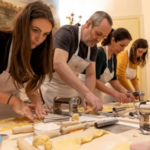The Japanese tea ceremony is a ritualistic practice that involves the preparation and consumption of matcha, a powdered green tea. Participants are guided through a series of precise movements and etiquette rules. The host carefully cleans and arranges the necessary utensils before whisking the matcha powder with hot water to create a frothy green tea.
Guests receive the tea with a respectful bow and drink it in a prescribed manner. This ceremony typically takes place in a tranquil environment, such as a traditional tearoom or Japanese garden, designed to promote a sense of calm and reflection. The tea ceremony holds significant cultural importance in Japan, representing more than just the act of drinking tea.
It embodies Japanese aesthetics, philosophical concepts, and social norms. The practice emphasizes mindfulness, mutual respect, and an appreciation for simplicity and beauty in daily life. Participating in a traditional tea ceremony offers insights into Japanese culture and values, while also providing an opportunity for personal introspection and a sense of inner tranquility.
Key Takeaways
- Experience the serene and meditative art of the Japanese tea ceremony, known as “chanoyu,” and gain insight into the cultural significance of this ancient practice.
- Immerse yourself in the traditions and rituals of Japan’s national sport, sumo wrestling, by attending a live tournament or observing the rigorous training of the wrestlers at a sumo stable.
- Embrace the elegance of Japanese fashion by participating in a traditional kimono dressing experience and learn about the history and symbolism of the kimono.
- Delve into the world of Japanese performing arts with a visit to a kabuki theater and gain a deeper understanding of this revered art form.
- Engage in a transformative spiritual practice by participating in a Zen meditation session at a traditional Japanese temple or monastery and learn about its principles and techniques from experienced practitioners.
Sumo Wrestling: Sumo wrestling is Japan’s national sport and one of the oldest martial arts in the world, with a history dating back over 1,500 years. The sport is steeped in tradition and ritual, with its roots in Shinto religious practices and ceremonies. Sumo wrestlers, known as “rikishi,” undergo rigorous training and adhere to strict rules and customs both inside and outside the ring.
Experience the Thrill of Live Sumo Tournaments
Attending a live sumo tournament, known as a “basho,” provides an immersive experience into the world of sumo wrestling. Held six times a year in Japan, these events offer spectators the chance to witness the intense matches and elaborate pre-bout rituals. From the ceremonial ring-entering ceremony to the fierce clashes between wrestlers, sumo tournaments are a spectacle of strength, skill, and tradition.
Behind the Scenes at a Sumo Stable
Visiting a sumo stable allows visitors to observe the daily training regimen of the wrestlers, which includes strict diets, intense physical conditioning, and practice bouts. This unique opportunity offers a glimpse into the discipline and dedication required to excel in this ancient sport.
Immersing in Sumo Traditions
By immersing oneself in the traditions of sumo wrestling, one gains a profound appreciation for its cultural significance and the values of honor, respect, and perseverance that are integral to the sport.
Kimono Dressing: The kimono is a symbol of Japanese tradition and elegance, with a history dating back over a thousand years. Wearing a kimono is an art form in itself, with intricate folding and tying techniques that vary depending on the occasion, season, and individual’s status. Participating in a traditional kimono dressing experience provides an opportunity to learn about the cultural significance of this iconic garment and to embrace the beauty of Japanese fashion.

The process of dressing in a kimono involves multiple layers of fabric, each carefully arranged to create a harmonious ensemble. The choice of kimono fabric, obi (sash), and accessories reflects not only personal style but also cultural customs and symbolism. By donning a kimono and walking through historic neighborhoods or visiting landmarks such as temples and gardens, participants can immerse themselves in the timeless elegance of Japanese fashion while gaining insight into the historical and social contexts of kimono wearing.
The kimono embodies the values of modesty, grace, and respect for tradition. By participating in a kimono dressing experience, individuals can gain a deeper understanding of Japanese aesthetics and etiquette while appreciating the craftsmanship and artistry involved in creating these exquisite garments. It is an opportunity to step into the past and experience firsthand the enduring allure of Japan’s traditional attire.
Kabuki Theater: Kabuki is a traditional form of Japanese theater that combines music, dance, elaborate costumes, and stylized movements to tell captivating stories from Japanese history and folklore. Dating back to the early 17th century, kabuki has evolved into a highly stylized art form with its own set of conventions and techniques. A visit to a kabuki theater offers an immersive experience into this revered performing art.
| Aspect | Description |
|---|---|
| Form | Kabuki theater combines music, dance, elaborate costumes, and stylized movements. |
| History | Dating back to the early 17th century, kabuki has evolved into a highly stylized art form. |
| Stories | Kabuki tells captivating stories from Japanese history and folklore. |
| Experience | A visit to a kabuki theater offers an immersive experience into this revered performing art. |
Kabuki performances are characterized by their dramatic storytelling, vibrant costumes, and exaggerated gestures. The actors, known as “kabuki-za,” undergo rigorous training from a young age to master the intricate movements and expressions that define kabuki theater. The performances often feature historical dramas, love stories, or supernatural tales, all brought to life through mesmerizing choreography and live musical accompaniment.
Attending a kabuki performance provides an opportunity to witness the artistry and spectacle of this traditional form of entertainment. From the elaborate makeup and costumes to the dynamic performances on stage, kabuki theater offers a window into Japan’s rich cultural heritage. By delving into the world of kabuki, one can gain a deeper appreciation for Japanese performing arts while experiencing the timeless allure of this centuries-old tradition.
Zen meditation, or “zazen,” involves sitting in silent contemplation, focusing on breath awareness, and cultivating a sense of presence and awareness. The practice is guided by experienced practitioners who offer instruction on proper posture, breathing techniques, and methods for quieting the mind. Through meditation, participants can experience a sense of tranquility and introspection while gaining insight into the profound teachings of Zen Buddhism.
The practice of Zen meditation encourages individuals to cultivate mindfulness in their daily lives, fostering a deeper connection with oneself and the world around them. By participating in a meditation session at a traditional Japanese temple or monastery, one can gain valuable insights into the principles of Zen Buddhism while experiencing moments of stillness and clarity amidst the hustle and bustle of modern life.
The Essence of Calligraphy
Calligraphy is an art form that emphasizes precision, balance, and fluidity in creating beautiful characters using brush and ink. Each brushstroke is imbued with intention and energy, reflecting the artist’s state of mind at the moment of creation. Through hands-on practice and instruction from experienced calligraphers, participants can learn to appreciate the artistry and discipline required to master this timeless craft.
Unleashing Creativity and Cultural Connection
Creating one’s own calligraphic pieces during a workshop allows individuals to unleash their creativity while gaining an understanding of Japanese aesthetics and symbolism. The process of writing characters with brush and ink can be both meditative and expressive, offering a unique way to connect with Japanese culture and language.
Immersing in the Art of Shodo
By immersing oneself in the art of shodo, participants can gain a deeper appreciation for the beauty and significance of Japanese calligraphy. This ancient art form offers a unique way to connect with Japanese culture and language, and to express oneself creatively through the precise and fluid movements of the brush.
Pottery making workshops allow participants to mold clay into beautiful vessels using traditional techniques such as wheel throwing or hand-building. The process involves shaping, glazing, and firing the pottery to create one-of-a-kind pieces that reflect the artist’s creativity and skill. Similarly, origami workshops provide an introduction to the art of paper folding, allowing participants to create intricate designs using simple folds and creases.
Indigo dyeing workshops offer insight into the ancient art of dyeing textiles with natural indigo pigment. Participants can learn about traditional dyeing methods and create their own indigo-dyed fabrics or garments using tie-dye or resist-dyeing techniques. These hands-on experiences not only showcase the craftsmanship involved in traditional Japanese crafts but also provide an opportunity for individuals to connect with their creative instincts while gaining an appreciation for Japan’s artistic heritage.
By participating in traditional craft workshops, individuals can gain a deeper understanding of Japanese culture while creating tangible mementos that reflect their personal creativity and connection to Japan’s rich artistic traditions. These immersive experiences offer a window into Japan’s vibrant craft heritage while providing an opportunity for hands-on learning and creative expression.
If you’re planning a trip to Japan and want to experience the top cultural activities, you should definitely check out this article on romeretreats.com. This article provides a comprehensive guide to the best cultural experiences in Japan, from visiting ancient temples and shrines to participating in traditional tea ceremonies and exploring the vibrant street markets. It’s a great resource for anyone looking to immerse themselves in the rich cultural heritage of Japan.
FAQs
What are some of the top cultural experiences in Japan?
Some of the top cultural experiences in Japan include visiting traditional tea houses, attending a traditional Japanese tea ceremony, exploring ancient temples and shrines, participating in a traditional Japanese festival, and staying in a ryokan (traditional Japanese inn).
What is a traditional Japanese tea ceremony?
A traditional Japanese tea ceremony, known as “chanoyu” or “sado,” is a ritualistic preparation and consumption of matcha (powdered green tea). It is a highly choreographed and meditative experience that emphasizes harmony, respect, purity, and tranquility.
What are some famous temples and shrines to visit in Japan?
Some famous temples and shrines to visit in Japan include the Senso-ji Temple in Tokyo, the Kinkaku-ji (Golden Pavilion) in Kyoto, the Todai-ji Temple in Nara, and the Itsukushima Shrine in Hiroshima.
What are traditional Japanese festivals like?
Traditional Japanese festivals, known as “matsuri,” are vibrant and lively celebrations that often feature processions, traditional performances, food stalls, and colorful decorations. Some popular festivals include the Gion Matsuri in Kyoto, the Nebuta Matsuri in Aomori, and the Awa Odori in Tokushima.
What is a ryokan and what can visitors expect from staying in one?
A ryokan is a traditional Japanese inn that offers a unique and immersive cultural experience. Visitors can expect to sleep on tatami mats, enjoy kaiseki (multi-course) meals, relax in communal hot spring baths, and experience traditional Japanese hospitality and service.









